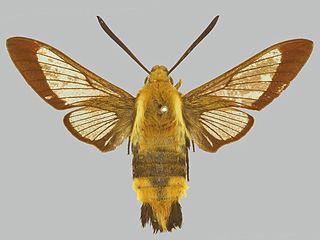Related Research Articles

Sphinx ligustri, the privet hawk moth, is a moth found in most of the Palearctic realm. The species was first described by Carl Linnaeus in his 1758 10th edition of Systema Naturae.

Erinnyis lassauxii, or Lassaux's sphinx, is a moth of the family Sphingidae.

Hemaris tityus, the narrow-bordered bee hawk-moth, is a moth of the family Sphingidae which is native to the Palearctic.

Hemaris fuciformis, known as the broad-bordered bee hawk-moth, is a moth of the family Sphingidae.

Marumba quercus, the oak hawk-moth, is a moth of the family Sphingidae. The species was first described by Michael Denis and Ignaz Schiffermüller in 1775.

Deidamia inscriptum, the lettered sphinx, is a species of moth of the family Sphingidae. It is the only member of the genus Deidamia. The species was first described by Thaddeus William Harris in 1839 and the genus was erected by James Brackenridge Clemens in 1859.

Macroglossum glaucoptera, the dark hummingbird hawkmoth, is a moth of the family Sphingidae. It was described by Arthur Gardiner Butler in 1875. It is known from Sri Lanka, Thailand, southern China, Vietnam, Malaysia (Peninsular), Indonesia and the Philippines (Mindanao). Single specimen recorded from Papua New Guinea.

Macroglossum pyrrhosticta, the maile pilau hornworm or burnt-spot hummingbird hawkmoth, is a hawk moth of the family Sphingidae. The species was first described by Arthur Gardiner Butler in 1875.

Eurypteryx is a genus of moths in the family Sphingidae.

Dolbina elegans, the ash hawkmoth, is a moth of the family Sphingidae. The species was first described by Andreas Bang-Haas in 1912. It is found from Ukraine, Moldavia, through eastern Romania and eastern and southern Bulgaria, northern Greece, western and southern Turkey to northern Syria, western Jordan, Israel, northern Iraq and northern Iran.

Platysphinx constrigilis is a moth of the family Sphingidae first described by Francis Walker in 1869. It is known from Africa.
Basiothia medea, the small verdant hawk, is a moth of the family Sphingidae. It is common in open habitats throughout the Ethiopian Region, including Madagascar. It is however probably absent from the equatorial forest belt, except as a vagrant. The species is an active migrant.

Polyptychoides grayii, or Gray's polyptychus, is a moth of the family Sphingidae. It is known from eastern Africa, south to South Africa.

Pseudoclanis occidentalis is a moth of the family Sphingidae. It is known from Sierra Leone, Ivory Coast, Ghana, Cameroon, Gabon, the Central African Republic and Kenya.

Macroglossum variegatum, the variegated hummingbird hawkmoth, is a moth of the family Sphingidae. It is known from north-eastern India, southern China, Thailand, Vietnam, Malaysia and Indonesia.

Nephele oenopion is a moth of the family Sphingidae. It is known from Africa.

Dahira obliquifascia, the black-striped dahira, is a moth of the family Sphingidae. It is known from north-eastern India, Nepal, Thailand, southern China, Taiwan, Vietnam and Peninsular Malaysia.

Eurypteryx alleni is a moth of the family Sphingidae. It is found in the Philippines, Sulawesi, Malaysia, Burma, Thailand and probably part of Indonesia.

Eurypteryx falcata is a moth of the family Sphingidae. It is known from Papua New Guinea.

Hemaris affinis, the honeysuckle bee hawkmoth, is a moth of the family Sphingidae. It is known from Mongolia, the Russian Far East, northern, central and eastern China, Taiwan, North Korea, South Korea and Japan.
References
- ↑ "CATE Creating a Taxonomic eScience - Sphingidae". Cate-sphingidae.org. Archived from the original on 2013-12-02. Retrieved October 26, 2011.
- ↑ Pittaway, A. R.; Kitching, I. J. (2018). "Eurypteryx dianae Brechlin, 2006". Sphingidae of the Eastern Palaearctic. Retrieved December 15, 2018.